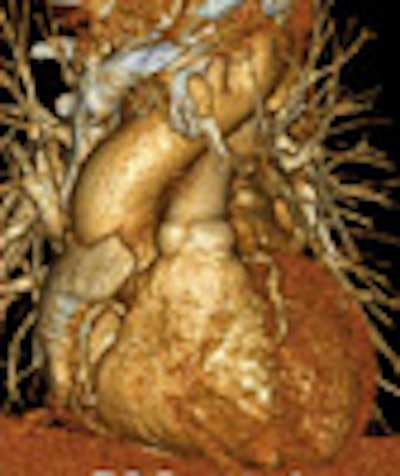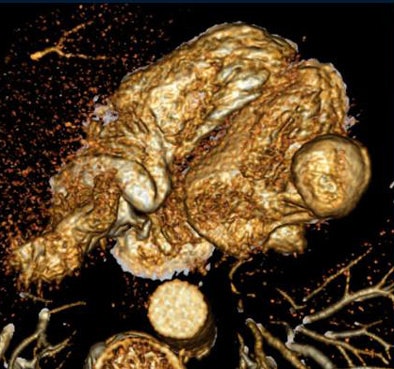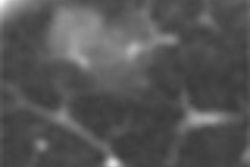
Researchers in the Netherlands believe that a largely overlooked group of patients may benefit significantly from coronary CT angiography (CTA). These individuals have no symptoms of coronary artery disease (CAD), but are at high risk of succumbing to it. Who are they?
"The ones you usually think of are those with high traditional Framingham (score) risk, and high calcium scores, but the ones I want to focus on are those with known symptomatic manifestations of atherosclerotic disease -- in other words carotid artery stenosis, renal artery stenosis, and chronic renal failure," said Dr. Mathias Prokop.
Current indications for CTA are quite limited: atypical angina, acute chest pain, unclear nuclear studies, and suspected aberrant coronary arteries, and for ruling out coronary disease preoperatively, such as before valvular surgery.
Patients with manifest vascular disease outside the heart don't fall into any of these categories, but they are particularly vulnerable to fatal cardiac events, said Prokop, who is a professor and chairman of radiology at University Medical Center Utrecht in the Netherlands. Prokop discussed the use of CTA in this group of patients at Stanford University's 2007 International Symposium on Multidetector-Row CT in San Francisco.
"If you look at why these patients die, coronary heart disease and strokes are the main causes of morbidity and mortality," Prokop said. "In patients with abdominal aortic aneurysm (AAA), stent implantation led to improved survival up to two years after the procedure," he said. "But after that, all the advantage of the stent implantation was gone, and the main reason for that was deaths due to coronary heart disease."
 |
| Reconstruction shows left ventricular aneurysm in a patient undergoing gated thoracoabdominal 64-detector-row CTA without beta-blockers. |
Before major vascular surgery, as many as 60% of patients with and without symptoms have significant coronary artery disease, and more than 70% have a significant stenosis, he said, citing two studies. Coronary artery disease accounts for up to 60% of perioperative and late mortality, and unrecognized myocardial infarctions are common (Circulation, July 15, 2003, Vol. 108:3, pp. 177-183; Canadian Medical Association Journal, September 27, 2005, Vol. 173:7, pp. 779-788).
Prokop's group at Utrecht decided to examine the CTA question in two groups of their own asymptomatic patients. As detailed later in this report, most are found to have significant, albeit asymptomatic, coronary artery disease.
A broader view
The Utrecht researchers' new potential indication for CTA in high-risk asymptomatic individuals can be viewed in the larger context of appropriateness for all new noninvasive cardiac imaging tests, particularly coronary CT angiography and cardiac magnetic resonance (CMR) imaging, which was the subject of an October report in the Journal of the American College of Cardiology.
What constitutes appropriate use of these noninvasive cardiac imaging technologies is in flux, and will remain so for years to come as trial results and clinical experience reveal which indications are clinically useful, and which do not yield sufficient new information or improved patient management to justify the expense -- and in the case of CTA, the radiation dose -- that accompanies the scans.
The JACC appropriateness guidelines were developed under the auspices of the American College of Cardiology (ACC) Foundation, which asked its panel of cardiac imaging experts to score a wide range of CTA and cardiac magnetic resonance (CMR) imaging applications for their current appropriateness. Each was scored from 0-8, with higher numbers indicating a greater likelihood of an application's eventually being deemed appropriate use (JACC, October 2006, Vol. 48, pp. 1475-1497; the full JACC report can be downloaded here).
Advances in noninvasive cardiac imaging offer "new opportunities for physicians to utilize noninvasive techniques to gain important information about the condition of their patients," the journal's coronary CT (CCT)/CMR writing group noted, cautioning that the tests are "relatively expensive technologies, especially with regard to imaging equipment. Additionally, the potential for uncontrolled utilization and stimulation of downstream testing and treatment such as unwarranted coronary revascularization has raised substantial concern from government and private payers, as well as clinical thought leaders of evidenced-based cardiovascular medicine."
Indications with the most substantial clinical underpinnings, such as imaging for intermediate pretest probability of coronary artery disease (score: 7) garnered the highest scores. Use of the tests in patients with a high or low pretest probability of CAD -- with correspondingly less evidence of efficacy -- got lower scores. Lacking convincing literature in its favor, imaging a patient with a previous uninterpretable ECG test who is unable to exercise for a stress test (score: 5) was an indication of "uncertain" utility, for example. CTA imaging of asymptomatic patients who have previously undergone coronary artery bypass graft (CABG) surgery was definitely not considered appropriate.
One currently "uncertain" indication -- using CTA in a patient with chest pain syndrome and an uninterpretable ECG -- is a case in point, said Gilbert Raff from William Beaumont Hospital in Royal Oak, MI, who discussed the JACC guidelines at the MDCT symposium. Because established efficacy is required to recommend an application, the criteria might seem quite narrow, he said.
In the case of chest pain and an uninterpretable ECG, CTA isn't entirely appropriate "because you have a well-established stress test that could be used, and has been used for at least 50 years," Raff said. "So the question is, do we have an appropriate use for CT as the primary initial test for patient with chest pain in the (doctor's) office, and the answer is 'no, we don't.'"
The JACC guidelines are "expert, not evidence-based opinion," Raff said. As such, the scores represent the consensus views of experts predicting the future -- views that can be expected to change as studies become available, he said.
Another currently "uncertain" indication is the so-called triple rule-out -- coronary CTA for the concurrent exclusion of obstructive CAD, aortic dissection, and pulmonary embolism. The triple rule-out is "technically feasible but accuracy has not been totally established by evidence," he said. On the other hand, "we know that coronary anomalies are viable for CT," Raff said of an indication that received a high score.
Summarizing the JACC guidelines, Raff noted that "symptomatic and (preoperative) patients have some support," for CTA in the guidelines, while the use of CTA in asymptomatic patients at high risk is "controversial but defendable." And there's good evidence to support CTA in patients with acute chest pain, he said.
The Utrecht team's new indication for CTA in certain asymptomatic patients, while controversial, could well be demonstrated by the evidence, according to Raff. "It was encouraging to me that high-Framingham-risk asymptomatic patients were even considered as possibly appropriate," Raff said of the group's initial work.
Asymptomatic patients with other vascular disease
Prokop described how Utrecht researchers have embarked on a four-center study examining patients with manifest peripheral artery disease who have no symptoms of coronary artery disease.
About 200 of these patients have been imaged so far, randomized into two groups: calcium scoring CT scan only with a planned five-year follow-up and no intervention; and patients who received both CT calcium scoring and 64-detector-row coronary CTA.
Patients with significant main stem stenosis would be referred directly to the cardiologists, who would determine their management going forward, he said. Those who had no main stem stenosis would be referred for dobutamine stress MRI. Patients with negative MRI would also be referred to cardiology for follow-up, "with the idea that if we find something significant, we would see a higher rate of intervention in these patients," Prokop said.
What surprised the researchers in the first 96 asymptomatic patients to undergo coronary CTA was "an extremely high rate of left main or left main equivalent stenosis (17%), much higher than we ever expected," Prokop said. "We powered the study for about 20% of patients having silent ischemia detected by dobutamine stress MRI, and we expected in the range of 1% to 5% of left main stenosis, so we were massively surprised by the high rate of these stenoses."
In addition, 23% of patients had right coronary artery stenosis, 43% had left anterior descending artery stenosis, and 21% had right circumflex artery stenosis at coronary CTA.
But the "most frightening" finding was the extremely low number of positives yielded by dobutamine stress MRI in these patients, he said. Only one (1.6%) had any visible ischemia and five patients (7.9%) had resting wall-motion abnormalities at MRI.
"In other words, it was exactly the opposite of what we expected: Almost no positive results from stress MRI, but a substantial amount of major coronary artery disease."
In contrast, CTA found single-vessel disease in 21% of the patients, two-vessel disease in 13%, and three-vessel disease in 10%. While CTA found the at-risk patients, stress MR identified negligible numbers of additional high-risk patients, he said.
Another group of asymptomatic patients underwent gated thoracoabdominal CTA without beta-blockers for workup for abdominal aortic aneurysm (AAA). Not surprisingly for this older cohort of 88 patients with prior coronary (mean age 71.4 years, ± 9.6 years), the scans have detected substantial proximal coronary artery stenosis, Prokop said. So far 37 patients (42%) showed significant proximal coronary artery stenosis in 70 coronary segments, while 17 (19%) had significant left main (equivalent) stenosis.
"Altogether we identified more than 50% of patients with massively increased preoperative risk," Prokop said. As for the patients randomized to only calcium scoring and five-year follow-up, "these are patients we have to worry about," he said, because the evidence suggests a poor prognosis with "substantially increased" mortality. The ongoing research will be presented at the 2007 RSNA meeting in Chicago.
By Eric Barnes
AuntMinnie.com staff writer
August 27, 2007
Related Reading
Gender differences seen in coronary plaque ruptures, August 21, 2007
Coronary CTA much improved with newer scanners, August 15, 2007
CTA finds serious incidental findings after CABG surgery, August 6, 2007
JAMA study: Coronary CTA poses substantial cancer risk in select patients, July 17, 2007
Coronary CTA results correlate with all-cause mortality, June 19, 2007
Copyright © 2007 AuntMinnie.com




















